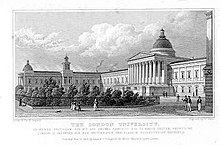Distance education
History
One of the earliest attempts was advertised in 1728. This was in the Boston Gazette for "Caleb Philipps, Teacher of the new method of Short Hand", who sought students who wanted to learn through weekly mailed lessons.[5]
The first distance education course in the modern sense was provided by Sir Isaac Pitman in the 1840s, who taught a system of shorthand by mailing texts transcribed into shorthand on postcards and receiving transcriptions from his students in return for correction. The element of student feedback was a crucial innovation of Pitman's system.[6] This scheme was made possible by the introduction of uniform postage rates across England in 1840.[7]
This early beginning proved extremely successful, and the Phonographic Correspondence Society was founded three years later to establish these courses on a more formal basis. The Society paved the way for the later formation of Sir Isaac Pitman Colleges across the country.[8]
The first correspondence school in the United States was the Society to Encourage Studies at Home, which was founded in 1873.[9]
Founded in 1894, Wolsey Hall, Oxford was the first distance learning college in the UK. [10]
University correspondence courses.
The University of London was the first university to offer distance learning degrees, establishing its External Programme in 1858. The background to this innovation lay in the fact that the institution (later known as University College London) was non-denominational and, given the intense religious rivalries at the time, there was an outcry against the "godless" university. The issue soon boiled down to which institutions had degree-granting powers and which institutions did not.[11]
The compromise solution that emerged in 1836 was that the sole authority to conduct the examinations leading to degrees would be given to a new officially recognized entity called the "University of London", which would act as examining body for the University of London colleges, originally University College London and King's College London, and award their students University of London degrees. As Sheldon Rothblatt states: "Thus arose in nearly archetypal form the famous English distinction between teaching and examining, here embodied in separate institutions.
Open universities[edit]
The Open University in the United Kingdom was founded by the-then Labour government led by Prime Minister, Harold Wilson, based on the vision of Michael Young. Planning commenced in 1965 under the Minister of State for Education, Jennie Lee, who established a model for the Open University (OU) as one of widening access to the highest standards of scholarship in higher education and set up a planning committee consisting of university vice-chancellors, educationalists, and television broadcasters, chaired by Sir Peter Venables. The British Broadcasting Corporation (BBC) Assistant Director of Engineering at the time, James Redmond, had obtained most of his qualifications at night school, and his natural enthusiasm for the project did much to overcome the technical difficulties of using television to broadcast teaching programmes.
Internet
The widespread use of computers and the internet have made distance learning easier and faster, and today virtual schools and virtual universities deliver full curricula online.[53] The capacity of Internet to support voice, video, text and immersion teaching methods made earlier distinct forms of telephone, videoconferencing, radio, television, and text based education somewhat redundant. However, many of the techniques developed and lessons learned with earlier media are used in Internet delivery.
The first completely online course for credit was offered by the University of Toronto in 1984 through the Graduate School of Education (then called OISE: the Ontario Institute for Studies in Education). The topic was “Women and Computers in Education”, dealing with gender issues and educational computing. The first new and fully online university was founded in 1994 as the Open University of Catalonia, headquartered in Barcelona, Spain. In 1999 Jones International University was launched as the first fully online university accredited by a regional accrediting association in the US.
Between 2000 and 2008, enrollment in distance education courses increased rapidly in almost every country in both developed and developing countries. Many private, public, non-profit and for-profit institutions worldwide now offer distance education courses from the most basic instruction through to the highest levels of degree and doctoral programs. New York University, International University Canada, for example, offers online degrees in engineering and management-related fields through NYU Tandon Online. Levels of accreditation vary: widely respected universities such as Stanford University and Harvard now deliver online courses—but other online schools receive little outside oversight, and some are actually fraudulent, i.e., diploma mills. In the US, the Distance Education Accrediting Commission (DEAC) specializes in the accreditation of distance education institution.
Educational technology
The modern use of electronic educational technology (also called e-learning) facilitates distance learning and independent learning by the extensive use of information and communications technology (ICT), replacing traditional content delivery by postal correspondence. Instruction can be synchronous and asynchronous online communication in an interactive learning environment or virtual communities, in lieu of a physical classroom. "The focus is shifted to the education transaction in the form of virtual community of learners sustainable across time.
One of the most significant issues encountered in the mainstream correspondence model of distance education is transactional distance, which results from the lack of appropriate communication between learner and teacher. This gap has been observed to become wider if there is no communication between the learner and teacher and has direct implications over the learning process and future endeavors in distance education. Distance education providers began to introduce various strategies, techniques, and procedures to increase the amount of interaction between learner and teacher. These measures e.g. more frequent face-to-face tutorials, increased use of information and communication technologies including teleconferencing and the Internet, were designed to close the gap in transactional distance















No comments:
Post a Comment